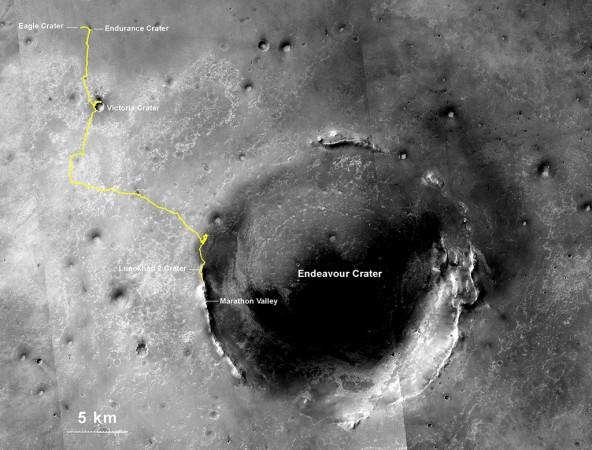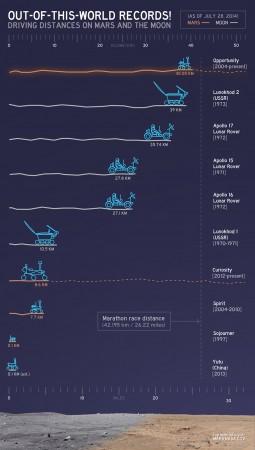
Opportunity, National Aeronautics and Space Administration's (NASA) Mars rover, which was sent to our neighbouring planet in 2004, has set a record for the longest distance travelled by a rover, outside earth.
The rover has travelled 40 km (or 25 miles) on Mars, breaking the previous record, held by Russian rover, Lunokhod 2, back in the Soviet era, revealed NASA. The Lunokhod 2 had travelled 39 km (or 25.23 miles) on the moon, in the year 1973.
"Opportunity has driven farther than any other wheeled vehicle on another world," said John Callas, Mars Exploration rover Project Manager, at NASA's Jet Propulsion Laboratory, Pasadena, California.
"This is so remarkable considering Opportunity was intended to drive about one kilometre and was never designed for distance," he added. "But what's really important are not how many miles the rover has racked up, but how much exploration and discovery we have accomplished over that distance."
On 27 July, Opportunity drove 48 m (157 feet). This drive broke the Lunokhod 2's record. According to the NASA, the Opportunity's current distance covered stands at 40.25 km (or 25.01 miles). The rover, which had landed on Mars in 2004, had driven a total of 32 km (or 20 miles) by the year 2011.
The Lunokhod 2, however, was much quicker in covering its 39 km. It covered the distance within a time period of 5 months in the year 1973, and its photos were captured by one of NASA's own satellites.

What is more important is the fact that if it continues on its current course, the Opportunity rover would reach the area, which has been named the "Marathon Valley" by the NASA scientists. They have been studying the pictures of this valley from different satellites, and believe that its clay is extremely rich in minerals.
If it does reach the marathon valley, the Opportunity rover would have travelled a total distance of 42.2 km (26.2 miles) at least, well surpassing the mark set by the Lunokhod.
However, NASA scientists were quick to downplay this as a victory over their old Russian rivals. The scientists at NASA also named a crater Lunokhod 2, to honour the previous record holding rover and their team, as the Opportunity neared its 40 km mark. The Lunokhod 2 crater is around six m (or 20 feet) in diameter.

"The Lunokhod missions still stand as two signature accomplishments of what I think of as the first golden age of planetary exploration, the 1960s and 70's," said Steve Squyres, Principal Investigators of NASA's twin Mars rovers (Opportunity and Spirit), and also a Scientist at Cornell University, Ithaca, New York.
"We're in a second golden age now and what we've tried to do on Mars with Spirit and Opportunity has been very much inspired by the accomplishments of the Lunokhod team on the moon so many years ago," he added.

















